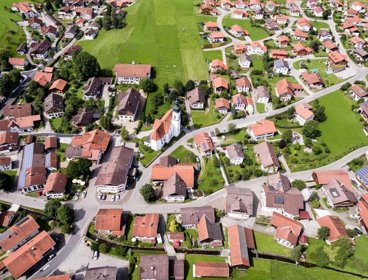What is meant by a suburb?
Traditionally suburbs are thought of as areas, towards the edge of an urban settlement, where the majority land use is low density housing, with convenience goods and services available locally. Their inhabitants tend to commute to the Central Business District for employment and for high order functions such as specialist retailing and entertainment.
How did suburbs develop?
It can be helpful to think of a walled medieval town when, quite literally, sub urban meant below the town. Imagine standing outside these high walls and therefore being outside the security of the town. Early suburbs were, therefore, undesirable locations. Living out here were the very poor and those with diseases such as leprosy. These were also the locations where all sorts of waste were dumped. If you read any of the crime fiction books written by Ellis Peters set in medieval Shrewsbury and starring a monk called Cadfael, you will come across good descriptions of early suburbs and their land uses.
After about 1750, towns and cities began to spill out beyond their walls. Interestingly, it was the wealthy who moved to these areas; this was classic greenfield development, as former market gardens and fields were taken over by fashionable districts of large houses.
This trend of outwards migration gathered pace during the 19th century and on into the 20th. The period between the First and Second World Wars, the inter-war period, saw massive suburban expansion in the UK and USA: between 1921 and 1931 about half a million houses were built around, what was then, London’s edge.
In the 1950s, suburban expansion started up again and has continued to the present day. Around many urban settlements, a Green Belt has been established. In this zone, development is restricted so as to prevent the continual outward sprawl of buildings.
Why did suburbs develop as they did?
Defensive walls became increasingly redundant as military technology and tactics advanced. From about the mid-18th century onwards, attitudes towards suburbs changed: instead of being places to avoid, they became desirable. The wealthy sector in society began to settle around the edge, beyond what was increasingly a crowded, polluted and dangerous central area. By the early 19th century, areas such as Bloomsbury were developed on what was then the northern edge of London.
Increasingly, during the 19th and 20th centuries, not just the wealthy moved out but also the growing numbers of people employed in the developing service sector, such as professionals (for example, doctors and lawyers), book keepers and clerks.
Two key factors gave energy to the process of suburbanisation; population growth and improvements in personal mobility. The former meant that demand for housing just kept rising and although residential densities in central locations rose, this could not be sustained. At first, only the wealthy carriage owning classes could live away from where they worked. Then during the Victorian and Edwardian times, commuting to work by horse-drawn buses, trams and railways became a reality for increasing numbers of people. Throughout the 20th century, buses and private motor cars became significant means of moving people from where they lived to where they worked.
Such increasing mobility needed not only technology to change but also an increase in disposable income for people to afford the costs of commuting.
Suburbs were, therefore, essentially, somewhere for people to live.
How have the functions of suburbs changed?
For much of the period of significant suburbanisation, residential land use dominated the outer areas. Mingled amongst the houses were the everyday services required by people such as shops for food and basic household goods, personal services such as hairdressers, doctors and dentists surgeries, schools and places of religious worship.
During the 20th century and in particular from the 1950s, some suburbs developed industrial and warehousing functions. The availability of large areas of greenfield land, its relatively low cost and the increasing importance of road access, meant that the edge of urban settlements had distinct advantages over more central locations.
The increasing scale of retailing has meant that this function too has moved out. Hyper-and super-markets are often located on the edge of settlements. And at certain locations, where transport links are good, office developments can be found.
Why not use Google Earth to view several suburban areas for yourself and identify the land uses evident?
What is the demographic makeup of suburbs and is it showing signs of changing?
Traditionally, suburbs have been categorised as where professional and managerial people and their families live. Such people have the income and security of employment to afford both the more expensive housing and the longer journey to work.
With the industrial developments referred to previously, areas of municipal housing were often built. These were occupied by those unable to afford or obtain loans (mortgages) to buy houses. In the UK the Right to Buy scheme encouraging local authority tenants to buy their house has caused further change with large numbers of rented houses entering the owner occupied sector.
As migrant groups become established within a society both economically and socially, they too have moved out to suburban locations. Interesting residential patterns are emerging in larger cities of distinct suburban clustering of different ethnic groups.
Are suburbs as monotonous and boring as people think they are?
Suburban is often used as a term of derision to imply something or someone as ordinary and uninspiring, perhaps lacking in style. There is a degree of uniformity about the housing; semi-or fully detached, front and back gardens, three/four bedrooms. But terraced housing of the inner city is uniform.
It is also interesting to consider just how diverse the suburban ecosystem is. Back gardens are something of a haven for a wide variety of insect, bird and mammal species, more so than some rural areas where agro-businesses operate.
It is, however, more than the housing that is being described as suburban, including a set of attitudes and a way of life. As with all stereotypes, there are elements of truth. Some television sitcoms have picked up on these in various ways such as The Good Life and Keeping Up Appearances.
However, this is to ignore the vast amount of creativity which takes place in suburbs. Large numbers of societies and groups covering a great diversity of activities operate in suburbs. One has only to go to your local library and study the notice board to discover just how much is going on in a relatively small neighbourhood. Music, drama, local history, sports, charities, visual arts, writing groups, reading groups, the list is not quite endless but it is long. The Beatles were essentially suburban boys.
Does the growth of suburbs ever lead to a new urban settlement forming?
As suburbs grew they often incorporated former villages and small towns into the built up area of the larger city. There are plenty of former ‘High Streets’ in suburban areas. Some locations develop significant functions, for example as office centres such as Harrow and Uxbridge within the London conurbation. But these were smaller market towns originally which have been incorporated within the outward growth of London.
In the USA, where urban areas tend to function at a larger spatial scale, new settlements have appeared. These ‘edge’ cities are on the very fringe of existing cities and should not be confused with the more general spread of urban development which we associate with suburbanisation. Edge cities tend to be largely self-sufficient settlements with their own housing, shops, business parks and entertainment. Irvine on the southern edge of Los Angeles is an example.
It is therefore, difficult to claim that suburbanisation has created new urban settlements.
Are suburbs still growing? If they are, are they still classed as suburbs or do they develop into something else?
In the UK the outward expansion of urban areas is strongly influenced by the planning systems. Many settlements have a Green Belt around them which restricts development. The attitude of government, both local and national, is a key factor in allowing building to occur in urban peripheries.
Wherever development takes place around urban settlements it can be described as suburban. As has been seen in the growth of cities in the past, neighbourhoods that were once on the edge, can be surrounded by subsequent building. For example, the area of Bloomsbury mentioned earlier, was once on the outskirts of London whereas today it is on the edge of London’s inner city.
Are suburbs developing in countries where there is rapid urban growth?
Patterns of intra-urban land-use in ELDW cities are changing. As disposable incomes and personal mobility rise, in particular amongst the emerging middle classes, suburbs are developing. The term used to describe these outer areas is peri-urban. They are characteristically, a mixture of natural and agro-ecosystems, industry of many types and scales, and a range of housing where people of different socio-economic status live. In some cities the municipal authorities buy land on the edge and build planned neighbourhoods but more commonly, private companies provide developments aimed at the upper end of the market. These can often include gated communities, where the houses are enclosed within walls and access is controlled. They are diverse and dynamic locations.
Have models of urban structure changed to take into account recent changes in suburbia?
Any model is a representation of reality and reflects, to a degree, the place and time in which the model is devised. Early models such as Burgess and Hoyt emerged from North America while Mann’s model is an interesting description of medium sized British cities. Many models have aspects which can be recognised as having some application to present day suburbs, such as the dominance of owner-occupied housing. It might be that one of you reading this will study Geography at university and develop your own model which brings up to date ideas about urban structure.
There are various models describing urban land-uses in other regions of the world and these, to a greater or lesser, extent include modern suburban developments. However, as these cities continue to evolve, so models will need to be up-dated.
What are the challenges facing suburban areas today?
Urban areas all around the world are dynamic. Their demographic, economic and political factors are changing and are likely to continue to do so.
A major challenge for all urban areas is to decide how to plan for and deliver a sustainable future and how to define what sustainability might mean. In EMDW suburbs, many suburban neighbourhoods are ageing having been built nearly a century ago. How should they be modernised and can they be adjusted to cope with rising population densities? In ELDW suburbs, issues of sustainability also arise. Increasing energy prices, rising expectations as regards living standards, concerns over water supply for example, are examples of matters which will need to be dealt with by both individuals and authorities.
Peter was interviewed in September 2011.
Dr Peter Stiff's biography
Dr Peter Stiff teaches at Sherborne School. He is a Principal Examiner for OCR and has written several textbooks.
He researched changing suburbs while the Fawcett fellow at UCL Geography Department and wrote two articles on this topic for Geography Review Volume 24, Number two and four.
Read more about the Fawcett Fellowships for Geography Teachers.




